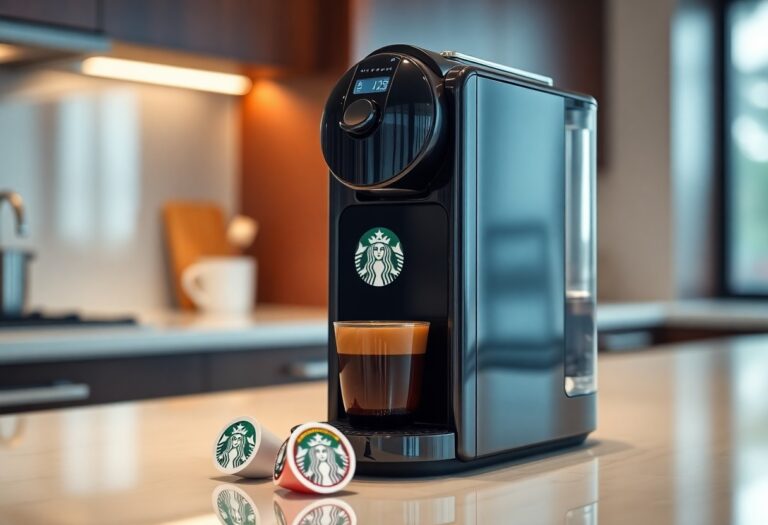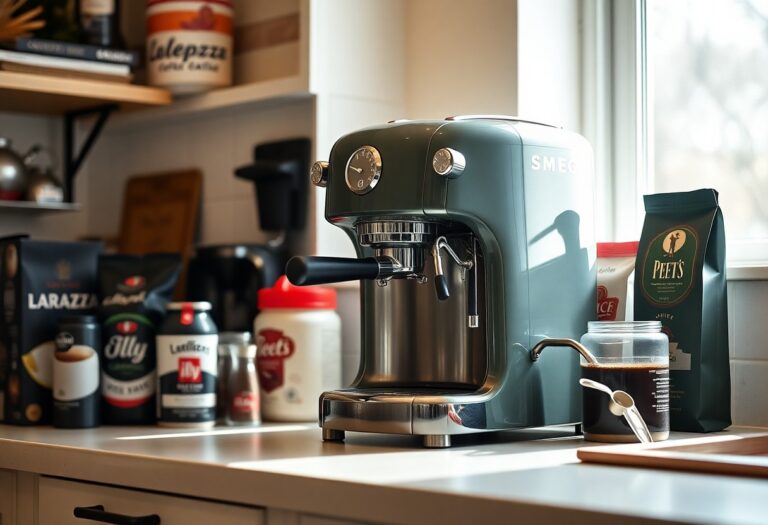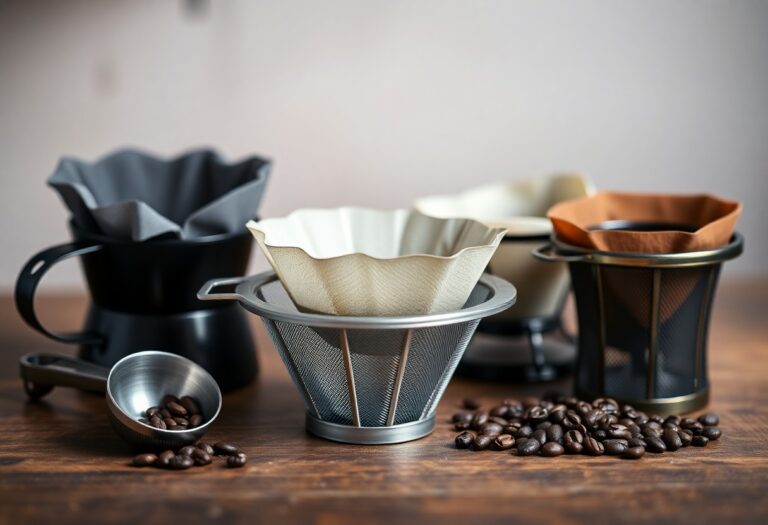What Coffee Grounds to Use for an Espresso Machine – Grind Guide
This guide will help you choose the best coffee grounds for your espresso machine to enhance your brewing experience. You’ll learn that espresso requires a fine grind for optimal extraction, which maximizes flavor and crema. It’s important to select fresh, high-quality beans and grind them just before use to preserve their rich aroma and taste. By following the right guidelines, you can avoid bitter or weak brews and enjoy a perfect shot of espresso every time.
Key Takeaways:
- The grind size for espresso should be fine, akin to that of table salt, to ensure proper extraction and flavor.
- Fresh coffee beans are crucial; grinding them just before brewing enhances aroma and taste.
- Espresso blends often combine different beans for balanced flavor, so experimenting with different blends can yield satisfying results.
- High-quality coffee beans tend to produce better espresso, so sourcing from reputable roasters is beneficial.
- Practice with the grind size and extraction time can help achieve the desired strength and taste profile in espresso.
The Art and Science of Espresso Grind Sizes
Achieving the perfect espresso involves mastering the delicate balance of grind sizes. From coarser grinds to those resembling powdered sugar, the specific grind you choose significantly influences flavor, aroma, and overall extraction quality. Understanding how these sizes interact with brewing methods will enhance your espresso-making skills and allow you to customize your drinks to perfection.
The Impact of Grind Size on Extraction
Grind size plays a pivotal role in the extraction process. Finer grinds create more surface area, allowing for quicker extraction of the coffee’s imperative oils and flavors, resulting in a richer shot. However, if the grind is too fine, it can lead to over-extraction, causing bitterness. Conversely, coarser grinds can under-extract, leaving the espresso weak and sour.
Symbiosis of Time and Pressure in Brewing
The synergy between grind size, brewing time, and pressure is fundamental for creating a balanced espresso. Each factor interacts to determine the final flavor profile, ensuring your espresso meets desired taste expectations.
The optimal brewing time for espresso typically ranges from 25 to 30 seconds, during which high pressure is applied. If your grind is too fine, the increased surface area may lead to faster extraction, but it can also create resistance against the water flow, extending extraction time and resulting in bitterness. On the flip side, if your grind is too coarse, water passes through too quickly, resulting in a sour taste due to under-extraction. Finding the right balance allows you to unlock the full potential of your coffee beans, yielding a perfectly brewed shot that embodies the nuances of your chosen roast. Adjusting grind size based on these parameters can be the key to consistent, delicious espresso every time.
Choosing the Right Coffee Beans
Selecting the right coffee beans is crucial for crafting an exceptional espresso. Look for high-quality beans, preferably Arabica varieties, known for their complex flavors and aromas. Consider exploring What Coffee To Use For Espresso Machines for a deeper understanding of your options and how they affect your brew. Your journey to the perfect espresso begins with making the right choice in coffee beans.
Single-Origin vs. Blends: Flavor Profiles Explained
Single-origin beans originate from a specific region, offering distinct flavors that reflect their growing conditions. You might find notes of fruit, chocolate, or nuts depending on the origin, which can elevate your espresso experience. In comparison, blends combine beans from various regions to create a balanced flavor profile, ensuring consistency and depth. Knowing your preferences can significantly enhance your espresso enjoyment.
The Importance of Roast Level for Espresso
The roast level of your beans plays a significant role in espresso flavor and extraction. Typically, espresso is crafted from medium to dark roast beans, with the darker roasts providing a more developed flavor and reduced acidity, resulting in a rich, bold cup. Yet, lighter roasts have their charm, often showcasing more delicate flavor notes that can be captivating when expertly brewed.
Choosing the right roast level is about balancing flavor and acidity. Medium roasts strike an exquisite balance, revealing complex flavor nuances while maintaining a harmonious acidity. Dark roasts provide a robust, bittersweet taste that can stand up to milk in café-style drinks. Experimenting with various roast levels allows you to discover your unique espresso preference, enhancing your brewing skills and tasting adventures.
Essential Grind Methods for Espresso Machines
Choosing the right grind method for your espresso machine significantly impacts the quality of your brew. Different espresso machines demand specific grind textures, with a fine, consistent grind being paramount for extracting the rich flavors and aromas from your coffee. Investing time in perfecting these grind methods not only enhances the overall taste but also optimizes the machine’s performance, making every shot a delight to savor.
Burr vs. Blade Grinders: A Deep Dive
The debate between burr and blade grinders centers on the consistency and quality of the grind. A burr grinder uses two revolving abrasive surfaces to crush coffee beans uniformly, producing a consistent particle size ideal for espresso. In contrast, a blade grinder employs sharp blades that chop the beans unevenly, leading to varying grind sizes which risks over-extraction or under-extraction in your shots. Opting for a burr grinder is vital for serious espresso enthusiasts.
Achieving Consistency: The Role of Grind Settings
Consistency in grind size is vital for extracting the perfect shot of espresso. Grinding your coffee beans to a fine, uniform texture ensures that water flows evenly through the coffee bed, maximizing flavor extraction. Adjusting your grind settings enables you to tailor the coffee’s taste according to your preference; whether you desire a richer profile or a lighter one, fine-tuning the grind helps achieve the balance you seek. For espresso, a grind size resembling granulated sugar will work wonders, providing optimal results.
When you adjust the grind settings on your burr grinder, you’re controlling the exposure of the coffee grounds to water. Finer grinds create a larger surface area, accelerating extraction, while coarser grinds slow down this process. This precision allows you to experiment with aspects such as brew time and pressure, fine-tuning your espresso’s flavor profile. Even minute alterations can transform a shot from mediocre to exceptional; for example, altering the grind by just a few clicks can mean the difference between a bright, fruity espresso and a heavy, chocolatey cup. Consistency in grind leads to repeatable results, arming you with the ability to perfect your brew every time.

Troubleshooting Common Espresso Grind Issues
If you notice your espresso isn’t hitting the mark, grinding issues could be to blame. Common problems such as under-extraction or over-extraction can occur if your grind consistency is off. Fine-tuning your grind size is imperative to achieving that rich, balanced flavor profile you’re aiming for. Small adjustments can make a significant difference, so let’s examine how to diagnose and correct these common grind-related issues.
Diagnosing Under- or Over-Extraction
Under-extraction results in a bitter, sour taste from your espresso, often due to a grind that’s too coarse or an insufficient brew time. Conversely, over-extraction leads to a dull, overly acidic flavor, generally linked to a grind that’s too fine or an extended brew time. By examining the taste and adjusting factors like grind size and brewing duration, you can pinpoint the extraction issue and enhance the overall taste of your espresso.
Adjusting Grind Size for Variable Brew Conditions
Varying brew conditions such as temperature, coffee freshness, or even atmospheric pressure can impact your espresso’s flavor. To cater to these fluctuations, you may need to adjust your grind size accordingly. For instance, if your machine’s temperature runs hotter than usual, consider using a finer grind to ensure optimal extraction, while cooler temperatures might call for coarser grounds to maintain balance.
For example, if you’re brewing during a particularly humid day, your coffee beans may absorb moisture, impacting their density and extraction rates. In this situation, slightly adjusting your grind to a coarser configuration can help counterbalance the effects of the humidity, ensuring that your espresso remains bold and flavorful. Likewise, if you’ve recently opened a fresh bag of beans, starting with a finer grind could help you extract the more vibrant flavors typically found in fresher coffee. Paying attention to these external factors and making quick adjustments to your grind size will lead to consistently excellent espresso shots.

Expert Tips for Maximizing Flavor Profiles
To truly elevate your espresso experience, focus on these expert strategies that can significantly enhance your flavor profiles:
- Prioritize quality beans sourced from reputable roasters.
- Explore varying brew temperatures to unlock distinct flavors.
- Adjust your extraction times based on taste tests.
- Utilize different water types to observe how it affects flavor.
- Incorporate subtle changes in coffee-to-water ratios for personalization.
Thou will discover a world of flavor nuances with these tips.
Freshness Matters: When to Grind for Optimal Taste
Grinding your coffee just before brewing is paramount for retaining the imperative oils that contribute to espresso’s rich flavor. Aim to grind within 15 minutes of your brew time, ensuring the beans make the most impact. Stale grounds lose their vibrancy, affecting the crema and overall profile. Invest in a hermetically sealed container to keep your beans fresh, whether whole or ground, for the longest possible duration.
Experimentation Techniques for Personalized Espresso
Crafting your ideal espresso is an art that thrives on experimentation.
Exploring different variables like grind size, brewing temperature, and extraction time can yield delightful results that cater to your palate. For instance, trying a finer grind paired with a shorter extraction time may amplify fruity notes, while a coarser grind with a prolonged brewing could bring out chocolatey flavors. Additionally, consider varying brands of coffee or blending beans from different regions to create a unique sensory experience. Always document your ratios and results to build a personalized espresso profile tailored to your taste preferences. Trust the process, and don’t hesitate to be bold in your choices.
Summing up
The choice of coffee grounds for your espresso machine plays a significant role in the quality of your brew. You should aim for a fine grind that maximizes extraction and enhances flavor. For tailored guidance, refer to this detailed resource on Espresso Grind – Choosing the Right Size. By selecting the right grind size, you’ll elevate your espresso-making experience and enjoy a richer, more flavorful cup.
FAQ
Q: What type of coffee beans are best for making espresso?
A: The best coffee beans for espresso are typically high-quality Arabica beans, as they offer a balance of acidity and sweetness. However, many espresso enthusiasts also appreciate the rich flavors of Robusta beans, which can add body and a crema to the shot. It often comes down to personal preference and experimentation with various blends to find the ideal taste profile for your espresso.
Q: How fine should the coffee grounds be for espresso?
A: The coffee grounds for espresso should be very fine, similar to the texture of table salt or slightly finer. This allows for optimal extraction during the short brewing time of about 25-30 seconds. If the grind is too coarse, the water will flow through too quickly, resulting in a weak and under-extracted shot. Conversely, if the grind is too fine, it can lead to over-extraction and a bitter flavor.
Q: Should I use fresh coffee grounds for espresso, and how can I ensure freshness?
A: Yes, using fresh coffee grounds is important for the best flavor and aroma in your espresso. Coffee beans start to lose their flavor soon after being ground, so it’s advisable to grind your beans just before brewing. To ensure freshness, store your coffee beans in an airtight container in a cool, dark place, and only grind what you need for each session.
Q: What grind settings should I use for different types of espresso machines?
A: The grind settings can vary depending on the type of espresso machine you are using. For traditional espresso machines, a very fine grind is recommended, while some semi-automatic machines may benefit from a slightly coarser grind. If you’re using a pressure-based machine or a stovetop Moka pot, adjust your grind to be around medium-fine. Always experiment to find the best setting that suits your machine and taste preferences.
Q: Is it possible to use pre-ground coffee for espresso, and what are the downsides?
A: You can use pre-ground coffee for espresso, but it may not deliver the same quality as freshly ground beans. Pre-ground coffee often lacks freshness, resulting in a less vibrant flavor and aroma. Additionally, it can be challenging to find the perfect grind size for your specific espresso machine when using pre-ground coffee. For the best espresso experience, using freshly ground coffee is highly recommended.







